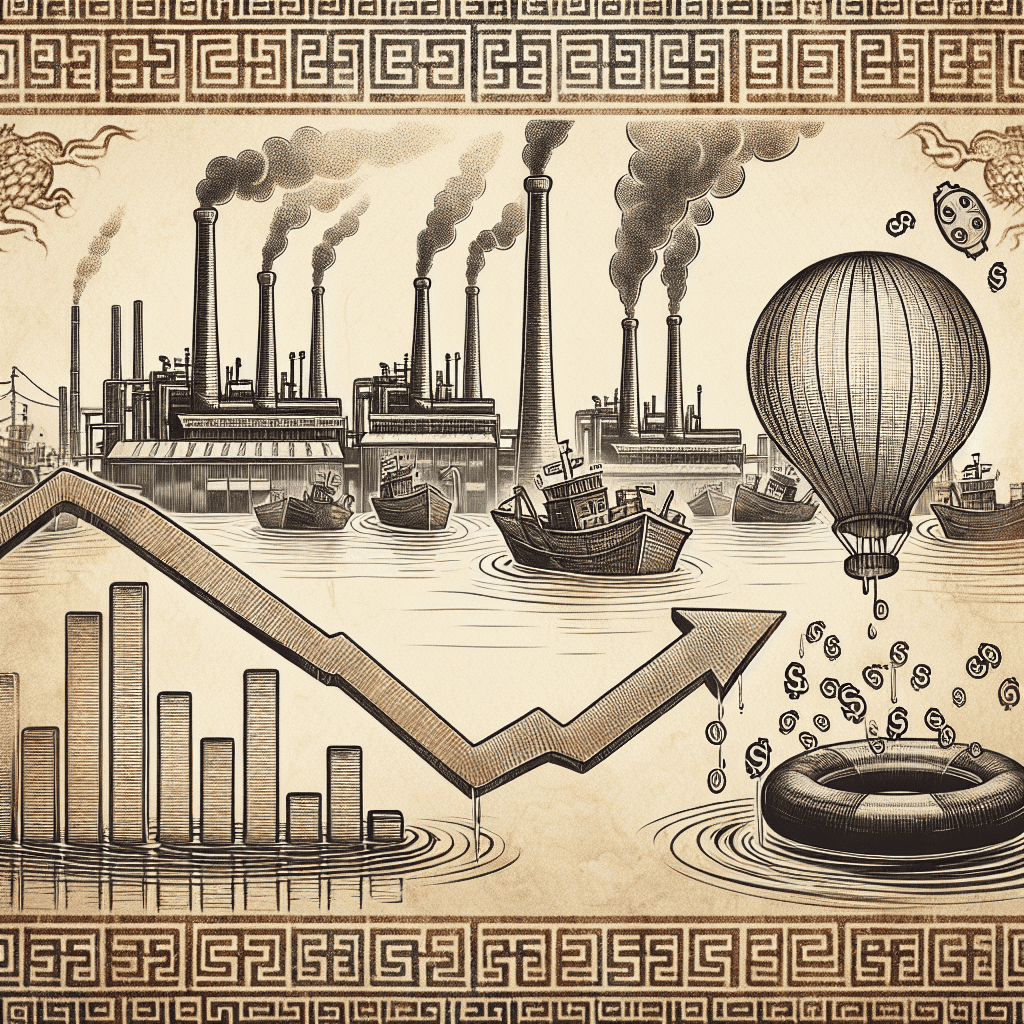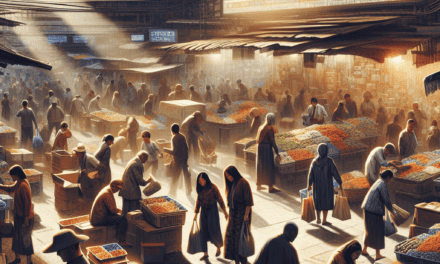“China’s Industrial Profits Plunge: Navigating the Deflation Dilemma”
Introduction
In recent months, China’s industrial sector has faced mounting challenges as profits continue to decline, exacerbated by the persistent impact of deflationary pressures. The world’s second-largest economy is grappling with a complex economic landscape, where sluggish domestic demand and global uncertainties have contributed to a downturn in industrial profitability. This trend highlights the broader economic struggles China is encountering, as it seeks to balance growth with stability in a rapidly changing global environment. The decline in industrial profits underscores the urgent need for policy interventions and strategic adjustments to revitalize the sector and sustain economic momentum.
Analysis Of China’s Industrial Profit Decline In The Context Of Global Economic Trends
China’s industrial sector, a cornerstone of its economic prowess, has been experiencing a notable decline in profits, a trend that has raised concerns both domestically and internationally. This downturn is occurring against the backdrop of broader global economic trends, including deflationary pressures that have been impacting various economies worldwide. To understand the implications of this decline, it is essential to examine the interplay between China’s internal economic dynamics and the external global environment.
The decline in industrial profits in China can be attributed to several interrelated factors. Domestically, the country has been grappling with a slowdown in economic growth, which has been exacerbated by structural challenges such as overcapacity in certain industries and a high level of corporate debt. These issues have been compounded by the Chinese government’s efforts to transition from an investment-driven growth model to one that is more consumption-oriented. While this shift is necessary for long-term sustainability, it has created short-term disruptions in industrial output and profitability.
Moreover, deflationary pressures have further complicated the situation. Deflation, characterized by falling prices, can lead to reduced revenue for companies as they are forced to lower prices to remain competitive. In China, deflation has been particularly pronounced in the producer price index, which measures the average change in selling prices received by domestic producers for their output. This has squeezed profit margins for industrial firms, making it difficult for them to maintain profitability.
In addition to domestic challenges, China’s industrial sector is also being affected by global economic trends. The ongoing trade tensions with major economies, particularly the United States, have introduced a layer of uncertainty that has disrupted supply chains and dampened export demand. Furthermore, the global economic slowdown, exacerbated by geopolitical tensions and the lingering effects of the COVID-19 pandemic, has weakened demand for Chinese goods, further impacting industrial profits.
Despite these challenges, it is important to recognize that China’s industrial sector is not monolithic. Some industries have been more resilient than others. For instance, high-tech manufacturing and sectors aligned with China’s strategic priorities, such as renewable energy and electric vehicles, have shown relative strength. These industries benefit from government support and are less susceptible to the deflationary pressures affecting traditional manufacturing sectors.
Looking ahead, the Chinese government is likely to implement a range of policy measures to stabilize industrial profits and support economic growth. These may include fiscal stimulus, monetary easing, and targeted support for key industries. However, the effectiveness of these measures will depend on the broader global economic context. If global demand remains weak and deflationary pressures persist, China’s industrial sector may continue to face headwinds.
In conclusion, the decline in China’s industrial profits is a multifaceted issue that reflects both domestic challenges and global economic trends. While the Chinese government is taking steps to address these challenges, the path to recovery will require careful navigation of both internal reforms and external uncertainties. As the world watches China’s economic trajectory, the interplay between domestic policy decisions and global economic conditions will be crucial in determining the future of its industrial sector.
The Role Of Deflation In Shaping China’s Industrial Sector Performance
China’s industrial sector, a cornerstone of its economic prowess, has been experiencing a notable decline in profits, a trend that has raised concerns among economists and policymakers alike. This downturn is intricately linked to the phenomenon of deflation, which has been exerting a profound influence on the country’s industrial performance. To understand the current state of China’s industrial sector, it is essential to explore the role of deflation and how it shapes the economic landscape.
Deflation, characterized by a general decline in prices, can have far-reaching effects on an economy. In the context of China, deflationary pressures have emerged as a significant challenge, impacting various facets of the industrial sector. One of the primary consequences of deflation is the reduction in consumer spending. As prices fall, consumers often delay purchases in anticipation of even lower prices in the future. This behavior leads to decreased demand for goods and services, which in turn affects industrial production and profitability.
Moreover, deflation can exacerbate the burden of debt for companies. In a deflationary environment, the real value of debt increases, making it more expensive for businesses to service their obligations. This situation is particularly concerning for China’s industrial sector, which has historically relied on borrowing to finance expansion and innovation. As profits dwindle and debt burdens grow, companies may find it increasingly difficult to invest in new technologies or expand their operations, further stifling growth.
In addition to these challenges, deflation can also lead to a vicious cycle of reduced investment and employment. As companies face declining profits, they may cut back on capital expenditures and workforce, leading to higher unemployment rates. This, in turn, reduces consumer spending power, perpetuating the cycle of deflation. In China, where the industrial sector is a major employer, such dynamics can have significant social and economic implications.
Furthermore, deflation can impact the global competitiveness of China’s industrial sector. As prices fall domestically, Chinese products may become less attractive in international markets, where prices might be more stable or even rising. This situation can lead to a decrease in export revenues, further straining the profitability of Chinese industries. In a globalized economy, maintaining competitiveness is crucial, and deflation poses a formidable obstacle in this regard.
Despite these challenges, it is important to note that deflation is not an insurmountable problem. Policymakers have several tools at their disposal to counteract its effects. For instance, monetary policy measures such as interest rate cuts or quantitative easing can help stimulate demand and encourage investment. Additionally, fiscal policies aimed at boosting infrastructure spending or providing targeted support to key industries can also play a role in mitigating the impact of deflation.
In conclusion, the role of deflation in shaping China’s industrial sector performance is multifaceted and complex. While it presents significant challenges, understanding its dynamics is crucial for devising effective strategies to address the current downturn in industrial profits. By implementing a combination of monetary and fiscal measures, China can navigate the deflationary pressures and work towards restoring growth and stability in its industrial sector. As the global economic landscape continues to evolve, the ability to adapt and respond to such challenges will be key to sustaining China’s industrial strength.
Strategies For Chinese Industries To Mitigate Profit Losses Amid Deflation
China’s industrial sector, a cornerstone of its economic prowess, has been grappling with a persistent decline in profits, exacerbated by the looming specter of deflation. As the world’s second-largest economy, China’s industrial performance is pivotal not only to its domestic growth but also to global economic stability. The deflationary pressures, characterized by falling prices, have eroded profit margins, compelling industries to explore strategic measures to mitigate these losses. In this challenging economic landscape, it becomes imperative for Chinese industries to adopt innovative strategies to navigate the deflationary tide.
One effective strategy is the diversification of product lines. By expanding their range of offerings, companies can tap into new markets and customer segments, thereby offsetting the impact of falling prices in their traditional markets. This approach not only helps in spreading risk but also in capturing emerging consumer trends, which can be particularly beneficial in a rapidly evolving economic environment. Moreover, diversification can lead to the development of niche products that command higher profit margins, thus providing a buffer against deflationary pressures.
In addition to diversification, enhancing operational efficiency is crucial. Streamlining production processes and adopting advanced technologies can significantly reduce costs, thereby improving profit margins even in a deflationary context. Automation and digitalization, for instance, can lead to substantial savings in labor and operational expenses. Furthermore, by leveraging data analytics, companies can optimize supply chain management, ensuring that resources are allocated efficiently and waste is minimized. This focus on efficiency not only aids in cost reduction but also enhances competitiveness in both domestic and international markets.
Another vital strategy is the strengthening of financial management practices. In times of deflation, maintaining a healthy cash flow becomes paramount. Companies should prioritize liquidity management, ensuring that they have sufficient reserves to weather economic downturns. This can be achieved through prudent financial planning, such as renegotiating debt terms and optimizing working capital. Additionally, industries should consider hedging against currency fluctuations and commodity price changes, which can further safeguard profits in an uncertain economic climate.
Furthermore, fostering innovation and investing in research and development (R&D) can serve as a catalyst for growth. By focusing on innovation, companies can develop cutting-edge products and services that meet evolving consumer demands, thereby creating new revenue streams. Investment in R&D not only drives product differentiation but also enhances brand value, which can be instrumental in maintaining pricing power even when overall market prices are declining. This strategic emphasis on innovation can position companies as leaders in their respective fields, providing a competitive edge that is crucial in a deflationary environment.
Lastly, collaboration and strategic partnerships can play a significant role in mitigating profit losses. By forming alliances with other companies, industries can share resources, knowledge, and expertise, leading to cost savings and enhanced market reach. Joint ventures and partnerships can also facilitate entry into new markets, providing opportunities for growth that might not be achievable independently. This collaborative approach can be particularly effective in industries where technological advancements and market dynamics are rapidly changing.
In conclusion, while deflation presents significant challenges to China’s industrial sector, it also offers an opportunity for companies to reassess and refine their strategies. By focusing on diversification, operational efficiency, financial management, innovation, and collaboration, Chinese industries can not only mitigate profit losses but also lay the groundwork for sustainable growth in the future. As these strategies are implemented, they will not only bolster individual companies but also contribute to the resilience and dynamism of China’s broader economic landscape.
Comparative Study: China’s Industrial Profits Versus Other Major Economies

China’s industrial sector, a cornerstone of its economic prowess, has been experiencing a notable decline in profits, a trend that has raised concerns both domestically and internationally. This downturn is largely attributed to the persistent deflationary pressures that have gripped the nation, creating a challenging environment for businesses. As we delve into a comparative study of China’s industrial profits versus other major economies, it becomes evident that the global economic landscape is undergoing significant shifts, with each country facing its unique set of challenges and opportunities.
To begin with, China’s industrial profits have been on a downward trajectory for several months, a situation exacerbated by deflation. Deflation, characterized by falling prices, can lead to reduced revenue for companies as consumers delay purchases in anticipation of even lower prices. This phenomenon has been particularly pronounced in China, where the industrial sector is grappling with excess capacity and sluggish domestic demand. Consequently, many Chinese firms have reported shrinking profit margins, which in turn affects their ability to invest in new technologies and expand operations.
In contrast, other major economies have shown varying degrees of resilience in the face of similar global economic challenges. For instance, the United States, while also experiencing inflationary pressures, has managed to maintain relatively stable industrial profits. This stability can be attributed to robust consumer spending and a diversified industrial base that is less reliant on any single sector. Moreover, the U.S. government’s fiscal policies have played a crucial role in supporting businesses through tax incentives and infrastructure investments, thereby bolstering industrial profitability.
Similarly, the European Union has faced its own set of economic hurdles, including energy price volatility and supply chain disruptions. However, the region’s industrial sector has demonstrated adaptability by shifting towards more sustainable and innovative practices. The EU’s emphasis on green technology and digital transformation has provided a buffer against profit declines, allowing many companies to maintain competitive edges in the global market. This strategic pivot has not only helped stabilize profits but also positioned European industries for future growth.
Japan, another major economy, presents a different scenario. The country has long struggled with deflationary pressures, similar to China, but has managed to mitigate some of the adverse effects through targeted monetary policies and structural reforms. Japan’s focus on high-value manufacturing and technological advancements has enabled its industrial sector to remain relatively resilient, despite the broader economic challenges.
As we compare these economies, it becomes clear that China’s industrial sector is uniquely impacted by its specific economic conditions. The combination of deflation, excess capacity, and shifting global demand patterns has created a perfect storm that continues to weigh heavily on industrial profits. However, it is important to note that China’s government is actively seeking solutions to reverse this trend. Initiatives aimed at stimulating domestic consumption, reducing excess capacity, and promoting innovation are being implemented to revitalize the industrial sector.
In conclusion, while China’s industrial profits continue to fall amid deflationary pressures, the experiences of other major economies offer valuable insights into potential strategies for recovery. By examining the diverse approaches taken by the United States, the European Union, and Japan, China can glean lessons on how to navigate its current challenges. Ultimately, the path to restoring industrial profitability will require a multifaceted approach that addresses both immediate concerns and long-term structural issues.
The Impact Of Government Policies On China’s Industrial Profitability
China’s industrial sector, a cornerstone of its economic prowess, has been experiencing a notable decline in profitability, a trend that has raised concerns among economists and policymakers alike. This downturn is intricately linked to the broader economic phenomenon of deflation, which has been exerting pressure on prices and, consequently, on profit margins. To understand the full scope of this issue, it is essential to examine the impact of government policies on industrial profitability in China, as these policies play a crucial role in shaping the economic landscape.
In recent years, the Chinese government has implemented a series of policies aimed at stabilizing the economy and promoting sustainable growth. These measures include monetary easing, fiscal stimulus, and structural reforms. However, while these policies have been designed to support economic activity, they have also had unintended consequences on industrial profitability. For instance, monetary easing, which involves lowering interest rates and increasing liquidity, has led to an increase in borrowing and investment. While this can stimulate economic growth, it can also lead to overcapacity in certain industries, thereby exacerbating deflationary pressures and squeezing profit margins.
Moreover, fiscal stimulus measures, such as increased government spending on infrastructure projects, have provided a temporary boost to certain sectors. However, these measures have not been sufficient to offset the broader deflationary trends affecting the industrial sector. The increased competition resulting from overcapacity has led to a race to the bottom in terms of pricing, further eroding profitability. Additionally, structural reforms aimed at reducing debt levels and improving efficiency have, in some cases, led to short-term disruptions in production and supply chains, adding another layer of complexity to the profitability equation.
Another critical aspect to consider is the role of international trade policies. China’s industrial sector is heavily reliant on exports, and recent geopolitical tensions have introduced new challenges. Trade disputes and tariffs have disrupted supply chains and increased costs for Chinese manufacturers, further impacting their profitability. In response, the Chinese government has sought to diversify its trade partnerships and reduce its dependence on traditional markets. However, these efforts take time to bear fruit, and in the interim, industrial profits continue to be under pressure.
Furthermore, the government’s focus on transitioning to a more sustainable and environmentally friendly economy has also had implications for industrial profitability. Stricter environmental regulations and the push for green technologies require significant investment from industries, which can strain financial resources and impact short-term profitability. While these initiatives are crucial for long-term sustainability, they add another layer of complexity to the current economic environment.
In conclusion, the decline in China’s industrial profitability is a multifaceted issue influenced by a combination of deflationary pressures and government policies. While the Chinese government has implemented various measures to stabilize the economy and promote growth, these policies have had mixed effects on industrial profitability. The interplay between monetary easing, fiscal stimulus, structural reforms, international trade dynamics, and environmental initiatives creates a complex landscape for China’s industrial sector. As policymakers continue to navigate these challenges, the focus will likely remain on finding a balance between short-term economic stability and long-term sustainable growth. Understanding this delicate balance is crucial for stakeholders seeking to adapt to the evolving economic environment in China.
Future Outlook: Can China’s Industries Recover From The Current Profit Slump?
China’s industrial sector, a cornerstone of its economic prowess, is currently grappling with a significant downturn in profits, a situation exacerbated by the persistent specter of deflation. This decline in industrial profits has raised concerns about the future trajectory of China’s economic growth and the potential ripple effects on the global economy. As the world’s second-largest economy, China’s industrial health is crucial not only for its domestic stability but also for international markets that rely on its manufacturing and export capabilities.
The current profit slump can be attributed to several interrelated factors. Firstly, the global economic slowdown has led to reduced demand for Chinese exports, a critical revenue stream for its industries. As international markets face their own economic challenges, the appetite for Chinese goods has diminished, leading to a surplus in supply and downward pressure on prices. This situation is further compounded by the ongoing trade tensions with major economies, which have introduced additional uncertainties and barriers to trade.
Moreover, the domestic market in China is also experiencing its own set of challenges. Consumer confidence has been shaken by the lingering effects of the COVID-19 pandemic, leading to cautious spending behavior. This has resulted in lower domestic demand for industrial products, further straining profit margins. Additionally, the Chinese government’s efforts to transition the economy from an investment-driven model to one focused on consumption and innovation have introduced structural changes that industries are still adapting to.
In light of these challenges, the question arises: can China’s industries recover from the current profit slump? The answer lies in a multifaceted approach that addresses both immediate concerns and long-term strategic adjustments. In the short term, government intervention may play a crucial role. Policymakers could implement measures such as fiscal stimulus packages, tax incentives, and monetary easing to provide immediate relief to struggling industries. These actions could help stabilize the industrial sector by boosting demand and alleviating financial pressures.
However, for a sustainable recovery, China’s industries must also focus on innovation and efficiency. Embracing advanced technologies such as artificial intelligence, automation, and green energy solutions could enhance productivity and reduce costs. By investing in research and development, Chinese industries can create high-value products that are competitive on the global stage, thereby opening new markets and revenue streams.
Furthermore, diversification of export markets is essential to mitigate the risks associated with over-reliance on a few major trading partners. By expanding trade relationships with emerging economies and participating in regional trade agreements, China can reduce its vulnerability to external shocks and enhance its industrial resilience.
In conclusion, while the current profit slump presents significant challenges for China’s industrial sector, it also offers an opportunity for transformation and growth. By addressing immediate economic pressures through government support and focusing on long-term strategic initiatives, China’s industries can navigate the current downturn and emerge stronger. The path to recovery will require concerted efforts from both the government and the private sector, but with the right policies and innovations, China’s industrial sector can regain its momentum and continue to be a vital engine of global economic growth.
The Relationship Between Consumer Demand And Industrial Profits In China
China’s industrial sector, a cornerstone of its economic prowess, has been experiencing a notable decline in profits, a trend that has raised concerns among economists and policymakers alike. This downturn is intricately linked to the broader economic phenomenon of deflation, which has been exerting pressure on consumer demand and, consequently, on industrial profits. Understanding the relationship between consumer demand and industrial profits in China requires a comprehensive examination of the underlying economic dynamics.
To begin with, consumer demand plays a pivotal role in shaping industrial profits. In a robust economic environment, strong consumer demand drives production, leading to increased sales and, ultimately, higher profits for industries. However, when deflationary pressures set in, consumer behavior tends to shift. Deflation, characterized by a general decline in prices, often leads consumers to delay purchases in anticipation of even lower prices in the future. This postponement of spending can result in a significant reduction in consumer demand, which directly impacts industrial output and profitability.
In China, the deflationary environment has been exacerbated by several factors, including global economic uncertainties and domestic challenges. The ongoing trade tensions with major economies have contributed to a cautious consumer sentiment, while domestic issues such as high levels of debt and structural economic adjustments have further compounded the situation. As a result, industries that rely heavily on consumer spending, such as manufacturing and retail, have been particularly hard hit.
Moreover, the relationship between consumer demand and industrial profits is further complicated by the supply chain dynamics. In a deflationary context, industries may face increased pressure to reduce prices to stimulate demand. However, this can lead to a vicious cycle where reduced prices squeeze profit margins, making it difficult for companies to invest in innovation and expansion. Consequently, the lack of investment can stifle productivity growth, further dampening industrial profits.
Additionally, the Chinese government’s policy responses to deflation have significant implications for consumer demand and industrial profits. Efforts to stimulate the economy through monetary easing and fiscal measures can provide temporary relief, but they also carry the risk of exacerbating debt levels and creating asset bubbles. Balancing these policy measures is crucial to ensuring sustainable economic growth and stabilizing industrial profits.
Furthermore, the global economic landscape plays a crucial role in shaping consumer demand and industrial profits in China. As a major player in international trade, China’s industrial sector is highly sensitive to fluctuations in global demand. A slowdown in key export markets can lead to reduced orders for Chinese goods, thereby impacting industrial profits. Conversely, a recovery in global demand can provide a much-needed boost to China’s industrial sector.
In conclusion, the relationship between consumer demand and industrial profits in China is a complex interplay of domestic and international factors. The current deflationary pressures have highlighted the vulnerabilities within this relationship, underscoring the need for strategic policy interventions and structural reforms. As China navigates these challenges, fostering a stable economic environment that encourages consumer spending and supports industrial growth will be essential for reversing the downward trend in industrial profits. By addressing both the immediate and long-term factors affecting consumer demand, China can work towards restoring confidence in its industrial sector and ensuring sustainable economic prosperity.
Q&A
1. **Question:** What is the current trend in China’s industrial profits?
– **Answer:** China’s industrial profits are continuing to fall.
2. **Question:** What economic condition is contributing to the decline in industrial profits in China?
– **Answer:** Deflation is contributing to the decline in industrial profits.
3. **Question:** How does deflation impact industrial profits?
– **Answer:** Deflation can lead to lower prices for goods and services, reducing revenue and profit margins for industries.
4. **Question:** Which sectors in China are most affected by the decline in industrial profits?
– **Answer:** Manufacturing and heavy industries are among the most affected sectors.
5. **Question:** What are some potential consequences of prolonged industrial profit declines in China?
– **Answer:** Potential consequences include reduced investment, layoffs, and slower economic growth.
6. **Question:** How might the Chinese government respond to falling industrial profits?
– **Answer:** The government might implement stimulus measures, such as monetary easing or fiscal support, to boost demand and stabilize prices.
7. **Question:** What are some indicators that analysts watch to assess the health of China’s industrial sector?
– **Answer:** Analysts watch indicators such as industrial output, producer price index (PPI), and purchasing managers’ index (PMI).
Conclusion
China’s industrial profits have continued to decline, reflecting the ongoing challenges posed by deflationary pressures in the economy. The persistent fall in profits highlights the difficulties faced by Chinese manufacturers and industries in maintaining pricing power and profitability amidst weakening demand and excess capacity. This trend underscores the broader economic challenges China faces, including slowing growth and the need for structural reforms to stimulate domestic consumption and investment. The decline in industrial profits may prompt policymakers to consider additional fiscal and monetary measures to stabilize the economy and support industrial sectors. Overall, the sustained drop in profits signals the urgency for China to address deflationary risks and bolster economic resilience.





